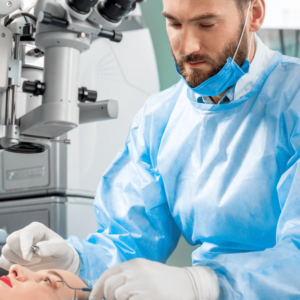What is Cataract Surgery?
Cataract surgery is a surgical procedure to remove the cloudy lens (cataract) from the eye and replace it with an artificial lens. Cataracts can cause blurred vision, sensitivity to light, and a decrease in color perception, among other symptoms. The procedure is typically performed as an outpatient procedure, and most people experience significant improvement in their vision following the surgery.
There are several surgical techniques for removing cataracts, including phacoemulsification, in which ultrasound energy is used to break up the lens into small pieces that can be easily removed, and extracapsular extraction, in which a larger incision is made in the eye to remove the lens in one piece. The choice of technique depends on the individual case and the surgeon’s preference and experience.
Cataract surgery is a very common and safe procedure, and the success rate is high. Most people achieve excellent vision following surgery with modern surgical techniques and advanced lens technology. However, as with any surgical procedure, there are potential risks and complications, such as infection, bleeding, and problems with the healing process. Your eye doctor will discuss these with you in detail and help you weigh the risks and benefits of the surgery.
How Long is Cataract Surgery Recovery Time?
The recovery time after cataract surgery varies from person to person, but most people experience significant improvement in their vision within a few days of the procedure. There may be some initial discomfort, such as sensitivity to light, itching, or a scratchy feeling in the eye, but these symptoms usually resolve within a few days.
Most people can return to their normal activities within a few days of the surgery, although it’s important to avoid activities that could put pressure on the eye, such as heavy lifting, for at least a week or two. Avoid swimming and other water activities until your doctor gives you the green light.
It’s essential to follow your eye doctor’s post-operative instructions, including using eye drops as directed, avoiding rubbing your eye, and protecting it from dust and other irritants. You will need to attend follow-up appointments with your eye doctor to monitor your progress and ensure that your eye is healing properly.
Overall, the recovery time after cataract surgery is typically short, and most people experience a rapid improvement in their vision. However, following your doctor’s instructions and attending all follow-up appointments is essential to ensure a successful outcome.
Post-Operative Care After Cataract Surgery.
After cataract surgery following your eye doctor’s instructions for post-operative care after cataract surgery is essential to ensure a successful outcome and reduce the risk of complications. Here are some general guidelines for post-operative care after cataract surgery:
- Use eye drops as directed: Your eye doctor will prescribe eye drops to help prevent infection, reduce inflammation, and promote healing. Use these eye drops as directed, and only stop using them if your eye doctor instructs you.
- Avoid rubbing your eye: Rubbing your eye can dislodge the artificial lens or cause other complications. If you experience itching or discomfort, use a cold compress or artificial tears to soothe your eye.
- Protect your eye from dust and other irritants: After surgery, your eye may be more sensitive to dust and other irritants. Wear sunglasses and a protective shield over your eye when you go outside, and avoid exposure to dust, smoke, and other irritants as much as possible.
- Avoid activities that put pressure on your eye: Heavy lifting, strenuous exercise, and other activities that put pressure on your eye can cause complications after cataract surgery. Avoid these activities for at least a week or two after surgery or until your eye doctor gives you the green light.
- Attend follow-up appointments: Your eye doctor will schedule appointments to monitor your progress and ensure your eye is healing properly. It’s essential to attend these appointments as directed and to keep all follow-up appointments.
- Report any problems: If you experience any problems, such as increased pain, redness, or vision changes, let your eye doctor know right away. Prompt treatment can help prevent complications and ensure a successful outcome.
Following these guidelines and attending all follow-up appointments can help ensure a successful outcome after cataract surgery and get back to your normal activities as soon as possible.
When Can You Return to Normal Activities?
The timeline for returning to normal activities after cataract surgery depends on several factors, including your overall health, the type of surgery you had, and the extent of your visual recovery. Here are some general guidelines:
- Rest: Most people can return to normal activities the day after cataract surgery. However, getting plenty of rest in the first few days after surgery is vital to allow your eye to heal.
- Physical activity: You can generally return to light physical activity, such as walking or gentle stretching, the day after surgery. However, you should avoid strenuous physical activity, such as heavy lifting or intense exercise, for several weeks after surgery.
- Work: If your job does not require physical labor, you can return to work the day after cataract surgery. If your job involves heavy physical activity or requires eye protection, you may need to wait several weeks before returning to work.
- Driving: If you had surgery in only one eye, you may be able to drive the day after the procedure if you feel comfortable and your vision is adequate. If you had surgery in both eyes, you should wait until your vision has stabilized before driving. This usually takes several days to a week or two.
- Bathing: You can generally resume bathing the day after cataract surgery. However, it’s important to avoid getting soap or water in your eye for the first few days after surgery.
- Swimming: You should avoid swimming and other water activities for several weeks after cataract surgery to reduce the risk of infection.
You must follow your eye doctor’s instructions and only return to normal activities when you feel comfortable, and your vision is adequate. You must immediately contact an eye doctor if you experience symptoms or complications after cataract surgery.
Driving After Cataract Surgery.
Driving after cataract surgery is generally safe, but when you can start driving again depends on several factors, including the type of surgery, the eye that was operated on, and your overall health. Here are some general guidelines:
- Single eye surgery: If you had surgery in only one eye, you may be able to drive the day after the procedure if you feel comfortable and your vision is adequate. However, checking with your eye doctor first is essential, as some people may experience vision problems after surgery that make driving unsafe.
- Both eyes surgery: If you had surgery in both eyes, you should wait until your vision has stabilized in both eyes before driving. This usually takes several days to a week or two. Your eye doctor can give you a specific timeline based on your case.
- Temporary vision changes: It’s normal to experience temporary vision changes after cataract surgery, such as blurred vision or light sensitivity. These changes should improve as your eye heals, but waiting until your vision has stabilized before driving is essential.
- Postoperative appointments: You must attend all follow-up appointments after cataract surgery to monitor your progress and ensure a successful outcome. Your eye doctor may also need to adjust your medications or perform additional tests to ensure your vision is adequate for driving.
- Safety tips: If you’re driving after cataract surgery, here are some safety tips to keep in mind:
- Wear sunglasses to protect your eyes from glare and bright light.
- Avoid driving at night, especially in the first few weeks after surgery.
- Avoid sudden movements, such as jerking the wheel or quickly accelerating or braking.
- If you experience double vision, halos, or other vision problems, pull over to a safe location and call your eye doctor.
It’s important to follow your eye doctor’s instructions and start driving when you feel comfortable, and your vision is adequate. If you experience vision problems while driving, it’s crucial to immediately pull over to a safe location and contact your eye doctor.
Side Effects and Complications of Cataract Surgery
Cataract surgery is generally safe and effective, but like any surgery, it is associated with risks and side effects. Here are some of the most common side effects and complications associated with cataract surgery:
- Pain: Some discomfort and pain are normal after cataract surgery, but it should be mild and manageable with pain medication. Contact your eye doctor immediately if you experience severe pain, redness, or swelling.
- Blurred vision: Your vision may be blurry immediately after cataract surgery, but this should improve as your eye heals. Contact your eye doctor if your vision does not improve or gets worse.
- Light sensitivity: You may experience sensitivity to light after cataract surgery, especially when you first go outside. This should improve as your eye heals.
- Dry eyes: Some people experience dry eyes after cataract surgery. If this occurs, your eye doctor may prescribe artificial tears or other treatments to relieve symptoms.
- Posterior capsule opacification (PCO): This common condition occurs when the back of the lens capsule (the part of the eye that holds the artificial lens in place) becomes cloudy. PCO can cause vision problems and may require treatment with a laser procedure.
- Infection: Although infection after cataract surgery is rare, it can occur. Symptoms of infection include severe pain, redness, swelling, and discharge from the eye. If you experience these symptoms, contact your eye doctor right away.
- Intraocular lens (IOL) dislocation: In rare cases, the artificial lens can become dislocated after cataract surgery. If this occurs, you may need another surgery to reposition the lens.
- Glare, halos, and double vision: Some people experience glare, halos, and double vision after cataract surgery, especially when driving at night. This can be due to a misaligned artificial lens or other issues and may require treatment with glasses or another surgical procedure.
Overall, cataract surgery is safe and effective, and most patients experience no significant complications. If you experience any symptoms that cause concern after cataract surgery, you must contact your eye doctor immediately.
Conclusion
Cataract surgery is a safe and effective procedure for treating cataracts, a common age-related condition that affects vision. The recovery time after cataract surgery varies, but most people can return to normal activities, such as driving and work, within a few days to a week.
However, it’s essential to follow your eye doctor’s instructions and to attend all follow-up appointments to monitor your progress and ensure a successful outcome.
You must contact your eye doctor immediately if you experience any symptoms or complications after cataract surgery. After cataract surgery, you can enjoy improved vision and a return to normal activities with proper care and monitoring.






